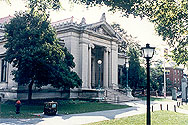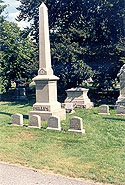
![]()
|
|
ProvidenceAt last I was to visit Lovecraft's home town. It took about an hour to reach from Boston on the 95, a straight and largely unvarying highway through green forest. There were a few rest points with signs posted encouraging you to stop there to fight off drowsiness. However, the signs also warned that there were no rest rooms, a policy which struck me as vaguely sadistic. I wasn't sure which offramp to use, and initially wound up in a distinctly unscenic harbor front area. After backtracking, I found a gas station where they, characteristically enough, had no maps to sell. However, the attendant helpfully suggested that I try the gift shop in the Holiday Inn across the street, where I succeeded in buying a good map of Providence and what later turned out to be a really bad map of Boston. Shortly thereafter, I crossed the river onto College Street and found myself in the College Hill area that is so helpfully mapped out in Eckhardt's pamphlet. It was Sunday and, perhaps because of that, there was little competition for parking. I was able to leave my car on Prospect St. just in front of Brown University. From that point, Eckhardt's walking tour of College Hill turned out to be a fairly easy walk that takes about two hours; though you could easily spend more time if you were in the mood to linger and explore the area, in the spirit of Charles Dexter Ward:
|
||
Athenaeum Library
|
At the corner of College Street and Benefit is the Athenaeum Library, one of Charles Dexter Ward's haunts. It is a chunky grey stone building with two pillars in front. The block of College Street uphill from the library is the former site of Lovecraft's last home, which was moved to make room for a new University building. A number of gracious old houses remain on the street, including a couple of dignified brick edifices and a couple of clapboarded domiciles painted fetching shades of lavender and light blue. (One of the oddities of travel in New England lies in observing the varied and often eccentric color choices that are often used on these fine old houses. I enjoy this far more than the enforced dullness of the color palettes in Southern California housing tracts.) |
|
Brown University
|
I strolled around Brown University for a bit, to get a flavor of the type of
mossy institution that Lovecraft might have had in mind when writing of
Miskatonic University. Brown is certainly a scenic campus with considerable
antiquarian interest, with towering old trees that half obscure the time-stained
stonework and small-paned windows of the halls of learning. The quad also
features the first truly green grass that I had seen in New England. On the
whole, this central portion of Brown could be a twin of Miskatonic, except that
everything is far too large; one has the sense that Misk. U. was of more modest
proportions, though at least equal age.
|

|
| Across Prospect Street, the John Hay library looks like a fitting repository for HPL's manuscripts, a huge and ornate white stone building. | ||
| First up was 598 Angell St., Lovecraft's second home. Because Angell St. is one way (the wrong way), you have to take Waterman St. down to Butler Ave. and then park near where it hits Angell. (Donovan Loucks informs me: "East of Butler, Angell is a two-way street, so you could have driven right up to the house if you'd wanted.") The front of the house is largely obscured by trees, but you can make out a beige dwelling with brown trim, several gables in the roof and a "bay window" type of protuberance in the front. The neighborhood is a quiet, shady area and seems like it would be a pleasant place to live. | ||
Phillips Family Plot
|
I took Butler north to Blackstone and continued up it to Swan Point Cemetery, whose entrance is bordered by stone walls. It is by far the largest cemetery I visited, a vast and rambling green expanse shaded by fine old trees and populated by monuments of every conceivable shape and size. A network of narrow paved roads confirms the impression that you have entered a veritable city of the dead. Eckhardt's pamphlet includes a map of these roads, but it is difficult to relate his map to the things you see, partly because many of the intersections have no signs, or else a sign that names only one of the roads that meet there. Still, I was able to find the Phillips family plot, which has a tall, obelisk-topped marker as its centerpiece. On the back of the family marker some unauthorized person has written
Lovecraft's own grave is located behind, and is marked by a small stone with his name, dates, and the motto "I am Providence." On the day I visited, a red rose lay in front of his marker, and a miniature small American flag stood beside it. Someone had left a letter to him on yellow notebook paper. I was tacky enough to read it, and was struck by the affectionate feelings it evidenced. Here was a man convinced, as few have been, of the temporary and accidental nature of our existence, of the fact that we exist only for the briefest of moments in a vast and indifferent universe that will take no note of our coming or going. It is intriguing to realize that such a person can inspire reverence, and even the desire to communicate with him beyond the grave. Yet from another point of view, it is perfectly understandable and expresses the very longing to transcend time that was such a keynote of Lovecraft's character. |
|
|
There is a lot to be said for old New England cemeteries. Though you might expect a visit to be morbid or even depressing, it has quite an opposite effect. How many people do you meet on an average day who are absolutely at peace? These ancient resting places are the quintessence of the message breathed out by all the antiquities of New England: that many have come and gone before us, each as real, vivid, full of feeling as ourselves, and have long since ceased to exist, as we will too in a short while. Individuals do not endure, but something surely does; the past lives on as the foundation of our present, and lingers onward still to echo in unimaginable futures. To feel this vividly is to experience the "adventurous expectancy" that Lovecraft spoke of, the dim and partial apprehension of some inconceivable quality that transcends our human limitations. After the cemetery, I stopped at a nearby collegiate-style eatery where the Cowboy Junkies were playing in the background, and copies of the New Yorker were strewn about for reading material. I decided to visit Other Worlds, a bookstore mentioned by Loucks. It is an exceedingly fine store for people of our taste, featuring mostly used or rare mysteries and science fiction / horror. They also have a good many small-press Lovecraftian publications in stock. It was strange to discover that the store has at least four names, being listed in the Yellow Pages as Other Worlds, but posted on the sign outside as Book Store, whereas the mystery portion is described on the owner's card as Murder by the Book and the cashier asked me to make the check out simply to By the Book. On seeing my out-of-state check, he also gave me an interesting lecture on Rhode Island's unique approach to people who write bad checks. Apparently the store owner simply calls the police, at which point they go directly to the person's house, arrest them and put them in jail. The cashier assured me that they were happy to issue arrest warrants out of state as well. His confidence was touching. Beckwith's book has additional tours I could have taken within Providence, but as I did not have access to his book on my trip, I decided to head back to Boston and see if I could fit in a short tour of the North End before sunset. Big mistake. |
||
|
Contents Previous: Salem Next: Boston Return to Cthulhu Mythos home page Send comments to jfm.baharna@gmail.com © Copyright 1997-2021 by Joseph Morales |
||